The ADATA XPG Levante 360 AIO Cooler Review: Stuck in the Middle
by E. Fylladitakis on April 4, 2022 8:00 AM ESTTesting Results, Maximum Fan Speed
Our maximum speed testing is performed with both the fans and the pump of the kit powered via a 12V DC source. This input voltage should have the pump and fans matching the speed ratings of the manufacturer. The Vento Pro fans rotate at just their rated speed, with our tachometer reading 2000 RPM. There was no difference between the three fans, hinting that the quality control is excellent.

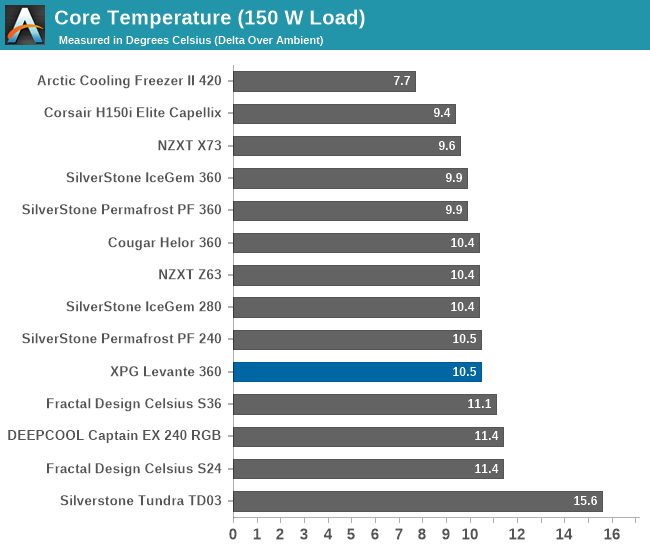
| Core Temperature, Constant Thermal Load (Max Fan Speed) |
The thermal performance of the XPG Levante 360 shows that the cooler performs about the same as other similarly-sized solutions, particularly those based on Asetek's reference design. The average thermal resistance of 0.0768 °C/W does not inspire awe for a cooler with such a massive radiator, but as one might expect, it's very close to the performance of other recent coolers with 360 mm radiators, which also puts it ahead of older coolers.
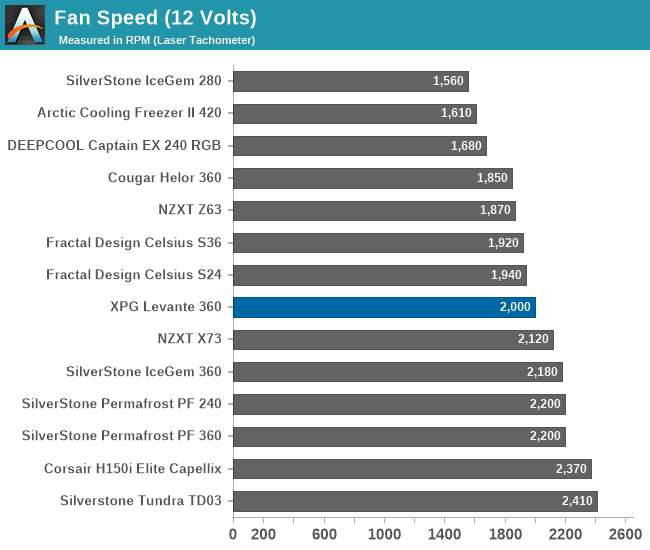
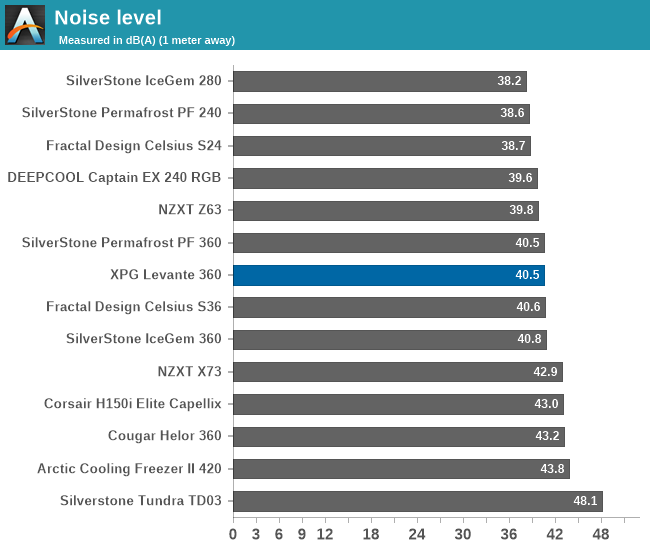
Three powerful 120 mm fans provide great airflow but they give a significant handicap to the Levante 360 when it comes to acoustics. With all three fans running at their maximum speed, we took a reading of 40.5 dB(A). This is not a bad figure for a cooler with three fans, but there are coolers that do it better, and such a loud cooler is not particularly comfortable for continuous use.
Testing Results, Low Fan Speed
Using a PWM voltage regulator, we reduced the speed of the fans manually down to half their rated speed, which is 1000 RPM for the Vento Pro 120 mm fans. The pump was also connected on the same power source, functioning properly at this low-speed setting.
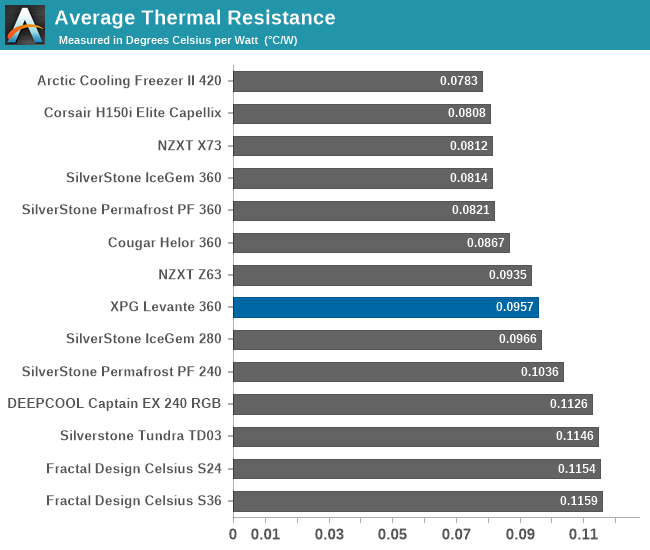
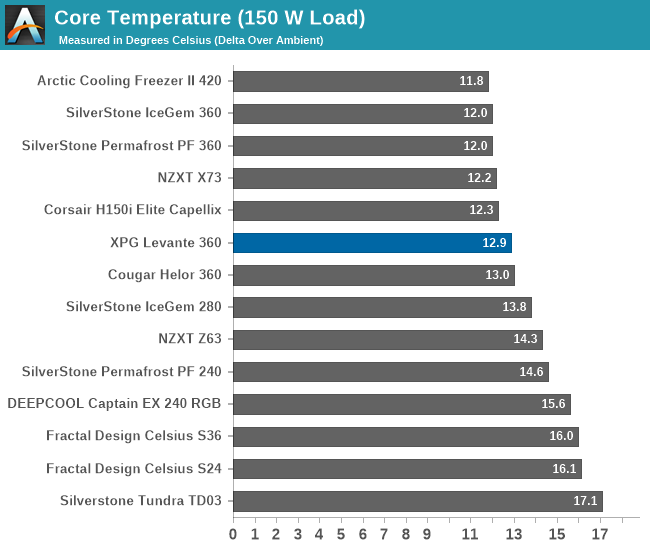
| Core Temperature, Constant Thermal Load (Low Fan Speed) |
This test initially suggests that the new XPG Levante 360 is significantly superior than older similarly sized coolers. With an average thermal permittance of 0.1036 °C/W, the Levante 360 is measurably better than older 360 mm coolers, such as the Fractal Design Celsius S36. However, a closer inspection reveals that the Levante 360 achieves this performance with its fans running at significantly higher speeds and, albeit the difference is minor, it does run louder.

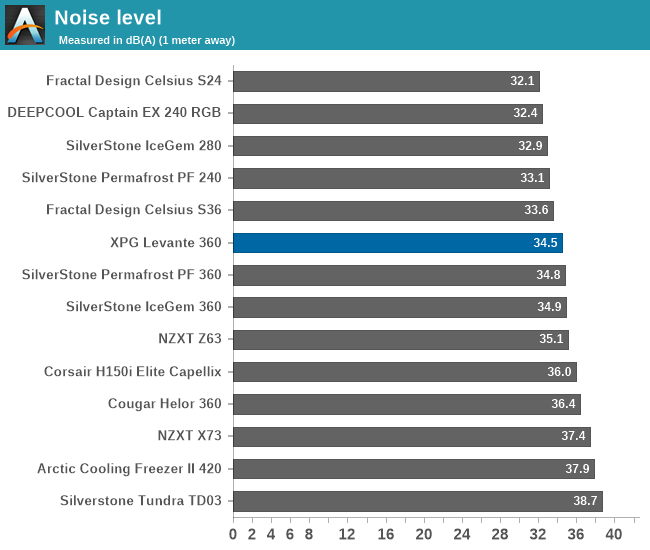
The noise output of the XPG Levante 360 under these operating conditions is 34.5 dB(A), a figure that is slightly audible but definitely comfortable for continuous use. The upside is that the pump is entirely silent, with no whining sounds or any form of noise coming from it, electromechanical or otherwise. The end result is that these noise figures are good for a cooler with three 120 mm fans, especially high-speed fans such as the Vento Pro.
Thermal Resistance VS Sound Pressure Level
During our thermal resistance vs. sound pressure level test, we maintain a steady 100W thermal load and assess the overall performance of the coolers by taking multiple temperature and sound pressure level readings within the operating range of the stock cooling fans. The result is a graph that depicts the absolute thermal resistance of the cooler in comparison to the noise generated. For both the sound pressure level and absolute thermal resistance readings, lower figures are better.
The graph displays that the XPG Levante 360 is a significant upgrade over older designs, capable of delivering significantly better thermal performance at the same sound pressure level. On the other hand, it brawls to compete with other recent releases of 360 mm radiator coolers, which tend to perform a little better and are capable of reaching lower thermal resistance figures. Compared to those coolers, the biggest advantage of the XPG Levante 360 is that it is capable of reaching lower noise levels, allowing the cooler to reach nearly inaudible noise figures while still delivering effective cooling performance.


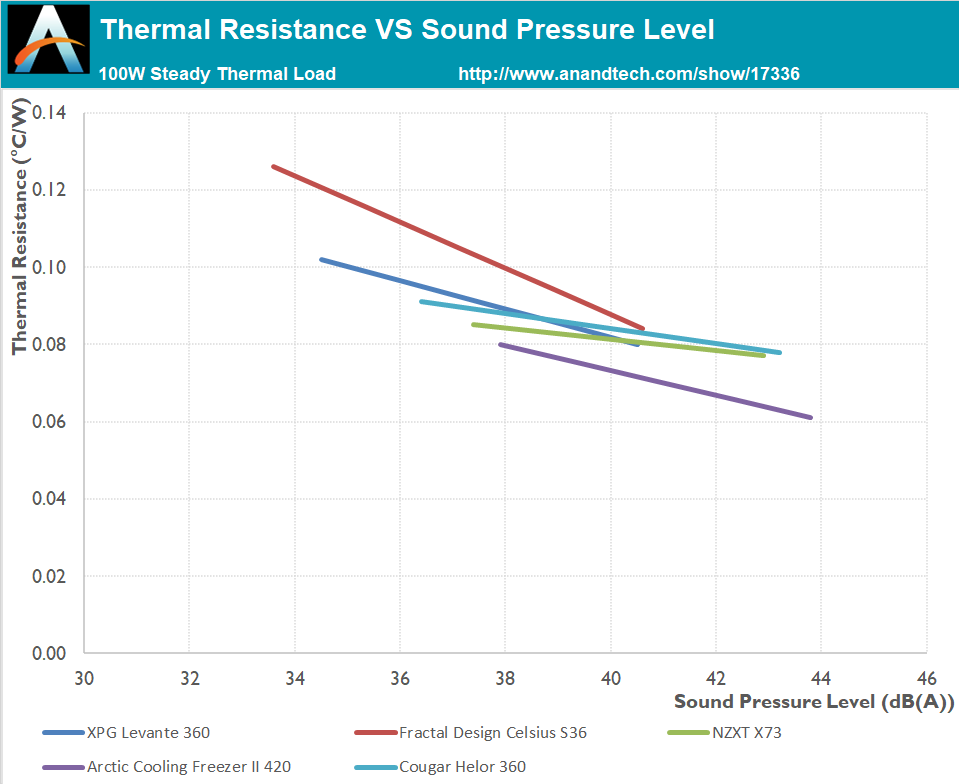








20 Comments
View All Comments
Oxford Guy - Monday, April 4, 2022 - link
PC enthusiasts are living in a strange fantasyland where CPUs need so much space and money devoted to efficient cooling but GPUs do not.theunshackled - Tuesday, April 5, 2022 - link
With power requirements rising on the next generation of RTX GPUs, either we look for our own adequate thermal solutions or let the manufacturers handle it themselves. The thing is though...I highly doubt that the 3rd party GPU vendors will sell cards without pre-built cooling, unlike the best 12th gen/Zen unlocked CPUs.That extra premium we pay ASUS/GIGABYTE/MSI/etc. to cool the GPUs are often good enough. I I agree that the reference fans/thermals, however, are often paltry.
meacupla - Tuesday, April 5, 2022 - link
That is such a dumb statement that totally ignores the fact that GPUs don't have a standardized mounting design where you can attach a standardized water block built that will fit.No, instead, we get a standard mounting hole around the GPU, but completely different plate designs that cool RAM and VRM for almost every single card out there, making cross compatibility a nightmare. This is why we get these asinine $400 GPU blocks that only fit one card, and why most AIO watercooler manufacturers stay the hell away from a GPU AIO cooler.
Oxford Guy - Tuesday, April 5, 2022 - link
‘That is such a dumb statement’If you’re referring to my post you’re way off because hacking on a water cooling system is hardly relevant to most enthusiasts. Water cooling loops are complex, expensive, and a hack.
I was obviously speaking to standards, standard equipment. If GPU makers had switched to the Fury X design of integrated water that would be a different matter. They have not. Only a few cards ship like that and they’re ridiculously overpriced. The existence of even the 3090 Ti in air-cooled form should be enough evidence for anyone to prove my argument.
The market is bizarrely warped into heavy space and cooling-to-noise ratio for CPUs and giving GPUs using vastly more power short shrift.
Oxford Guy - Tuesday, April 5, 2022 - link
And, by referencing Fury X I was not implying that only a 120mm radiator integrated with a GPU is necessarily adequate. Here, once again, we have a triple-fan radiator for a CPU. Where are the triple-fan water-cooled radiators integrated into GPUs?Nomgle - Wednesday, April 6, 2022 - link
They're on the market - https://www.sapphiretech.com/en/consumer/toxic-rad... as an example.Oxford Guy - Monday, April 11, 2022 - link
No doubt at an extremely premium price + an overclock that helps to negate the benefit.There is a big difference between that an something considered much closer to standard equipment.
Moonub - Saturday, April 23, 2022 - link
I’m with you Oxford Guy. We need GPUs to start offering a standard option for extra cooling - basically give us a mount of a GPU AIO cooler, right ? It would be great. I guess for the card manufacturers, they are selling the cooler as part of their value add and don’t benefit from opening up the GPU as a platform for other cooling products. This is probably what holds this back.shabby - Tuesday, April 5, 2022 - link
Pepperidge farm remembers when intel used to include coolers with their cpus... but only to hit the base clock 😂Khanan - Tuesday, April 5, 2022 - link
You can mod your GPU, never saw waterblocks? And that’s just an example.